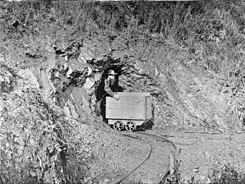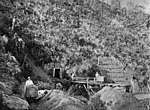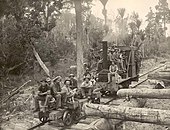Kuaotunu
| Kuaotunu | ||
| Geographical location | ||
|
|
||
| Coordinates | 36 ° 43 ′ S , 175 ° 44 ′ E | |
| Region ISO | NZ-WKO | |
| Country |
|
|
| region | Waikato | |
| District | Thames-Coromandel District | |
| Ward | Mercury Bay Ward | |
| Residents | 345 (in Rings Beach, Kuaotunu and West Kuaotunu, as of 2001) | |
| Post Code | 3592 | |
| Telephone code | +64 (0) 7 | |
| Photography of the place | ||
 Mr. Goldsworthy pushes a cart out of the Irene adit of the Try Fluke Mine, 1890s |
||
Kuaotunu is a settlement on the coast of the Coromandel Peninsula at the mouth of the Kuaotunu River on the North Island of New Zealand .
Surname
The name is derived from the Maori language: 'arousing fear in young animals' or 'grilled young animals' probably refers to the good hunting and fishing grounds in the area.
tourism
Kuaotunu is located on the Coromandel Tourist Circuit and is a popular destination for summer vacationers. It offers one of the northernmost beaches on the Coromandel Peninsula and is popular with campers and beach holidaymakers.
Mining
The gold mines and their stamping mills that were built there at the end of the 19th century had hopeful names such as Try Fluke, Carbine, Mariposa, John Bull, Great Mercury, Red Mercury, Irene, Waiawa, Otama and Kapai-Vermont.
The Try Fluke Mine was an abundant gold mine in Kuotunu in the late 19th century . Its name goes back to a gold find in 1889, when prospectors asked Maori Charles Kawhine, commonly known as Coffin , what he was doing, the latter supposedly replied, "Oh, try fluke - Oh, aim for random hits." At least that was understood instead of “tryin 'luck - tryin' my luck”, and the name has established itself for the gold mine located there.
The gold located on a mountainside mine consisted of a plurality of horizontal tunnels and vertical shafts . Some of them can still be used. One leads 50 m into the mountain and ends at a filled shaft. In front of the shaft there is a leveled area on which the mine railway ran. More than 2,760 ounces of gold were recovered by January 1893 after the Cassel cyanide separation process was introduced, which increased the percentage of gold recovered from roasted and crushed quartz from 55% to 95%. Official Thames Mines production data indicates a result of 2,327,619 ounces of bullion valued at NZ $ 845 million .
Timber industry
The timber industry only played a secondary role, but the mines required a lot of kauri wood for both pillars and buildings as well as for heating the quartz stoves. Therefore locals loggers operated a narrow gauge - forest railway with a small steam locomotive.
The locomotive with a track width of probably 2 feet 6 inches (762 mm) of Manning, Wardle & Co in Hunslet , England produced with the serial number 859 from 1883 and exported to New Zealand. Since the 6 km route was flat and had little or no sidings, the empty bogies were usually pushed into the bush and pulled back after being loaded with logs. This procedure reduced the risk of derailment of the loaded long timber trolleys, as pulling caused fewer derailments than pushing.
The Kuaotunu bush contained approximately 14,000 solid meters (6 million super feet ) of lumber. EH Irving worked as a contractor for the Kauri Timber Company (KTC) from 1907 to 1909. He and his Bushmen felled and transported the logs to the mouth of Whangapoua Harbor, where they were unloaded, processed into rafts and towed to a KTC sawmill on a powerful steamboat.
Web links
Individual proof
- ↑ Kuaotunu Community Plan. December 2009. Retrieved May 9, 2020.
- ↑ a b c d Carol Wright: Kuaotunu - Boom! Bustle! Bust! With excerpts from 'This is Kuaotunu' by RA (Alf) Simpson. Pp. 16-20. Retrieved August 3, 2018.
- ↑ a b Try Fluke Gold Mine (Coromandel). Retrieved August 3, 2018.
- ↑ The Cassel Process at Kuaotunu. New Zealand Herald, Volume XXX, No. 9110, January 30, 1893, p. 5. Retrieved August 3, 2018.
- ↑ Grace's Guide: Cassel Cyanide Co. Retrieved August 3, 2018.
- ^ A b Paul Mahoney: The era of the bush tram in New Zealand. IPL Books, Wellington, New Zealand, 1998. ISBN 0908876807 .




